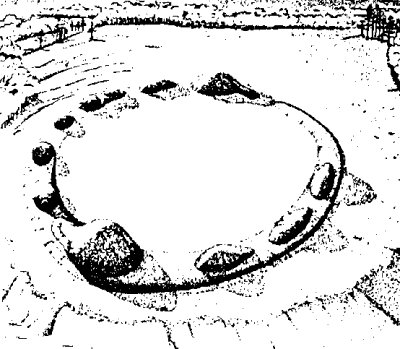 |
Science Frontiers ONLINE No. 114: Nov-Dec 1997 |
|
|
About As Anomalous As Mounds Can Get
The title refers to a circle of 11 earthen mounds located new Monroe, Louisiana; the Watson Break site. Local residents have known about the mounds for years, but archeologists weren't attracted to them until clear-cutting of the trees in the 1970s made the size and novelty of Watson Break all too obvious.
Just how anomalous is Watson Break? Archeologist V. Steponaitis, from the University of North Carolina, opined:
"It's rare that archaeologists ever find something that so totally changes our picture of what happened in the past, as is true for this case."
On what does Steponaitis base such a powerful statement?
- Watson Break is dated at 5,0005,400 BP (Before Present), some three millennia before the well-known Moundbuilders started piling up earthen structures from the Mississippi Valley to New York State. In other words, the site is anomalously early.
- Indications are that Watson Break was built by hunter-gatherers, but no one really knows much about them; there's an aura of mystery here.
- Watson Break consists of 11 mounds -- some as high as a two-story house -- connected by a peculiar circular ridge 280 meters in diameter. The back-breaking labor required to collect and pile up all this dirt is incompatible with the life style of mobile bands of hunter-gatherers.
- The purpose of the Watson Break complex escapes us. Why the mounds? Why the circular ridge? Can we just shrug it off as a "ritual site"?
(Saunders, Joe W., et al; "A Mound Complex in Louisiana at 5400-5000 Years before the Present," Science, 277:1796. Also: Pringle, Heather; "Oldest Mound Complex Found at Louisiana Site," Science, 277:1761, 1997. Also: Stanley, Dick; "Finds Alter View of American Indian Prehistory," Austin American Statesman, September 19, 1997. Cr. D. Phelps.)
Comment. If you have been following the archeological news stories, you have seen at least three items destined to "revolutionize" the prehistory of the Americas: (1) The Watson Break site; (2) The Monte Verde site (more than 12,500 years old, SF#112); (3) Kennewick Man (a Caucasian skeleton 9,300 years old in North America, SF#109).
 | The mounds and ring structure at Watson Break, Louisiana. (Smithsonian sketch). |